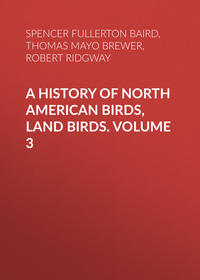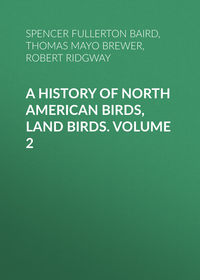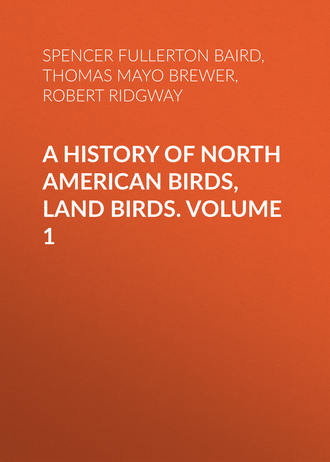 полная версия
полная версияA History of North American Birds, Land Birds. Volume 1
A little more light has since then been given both as to its geographical distribution and its mode of nesting. Specimens of this species have been obtained in Costa Rica, Guatemala, Oaxaca, Mexico, and Panama. A specimen of this species was also taken in Colombia, S. A., by Mr. C. W. Wyatt. Dr. Gundlach mentions it as occasionally found in Cuba. Mr. Drexler secured specimens of it at Moose Factory and at Fort George in the arctic regions. Specimens were taken by Mr. Bernard R. Ross at Fort Simpson. Mr. Robert Kennicott met with it on the northern shores of Lake Winnipeg, June 6. They were then abundant, and had already mated. He again met with them at Fort Resolution, and Mr. Clarke found them at Fort Rae, Mr. W. F. Hall in Maine, Mr. Bell on the Upper Missouri, and Professor Baird in Pennsylvania. Mr. Ridgway has obtained it both in spring and in fall in Southern Illinois, where it is abundant in some seasons. It does not appear to occur on the Pacific coast.
Mr. Boardman writes that the Tennessee Warbler is, in the summer time, quite a common bird in St. Stephens and vicinity. Its notes, he adds, resemble the low, subdued whistle of the common Summer Yellow-Bird.
Mr. Maynard found this Warbler very common near Lake Umbagog during the breeding-season. It was found in all the wooded localities in the regions north of the neighboring mountains. Its song, he states, resembles that of H. ruficapilla, the notes of the first part being more divided, while the latter part is shriller.
A nest of this Warbler (Smith. Coll., 3476), obtained on the northern shore of Lake Superior by Mr. George Barnston, is but little more than a nearly flat bed of dry, matted stems of grass, and is less than an inch in thickness, with a diameter of about three inches. It is not circular in shape, and its width is not uniform. Its position must have been on some flat surface, probably the ground. The eggs resemble those of all the family in having a white ground, over which are profusely distributed numerous small dots and points of a reddish-brown, and a few of a purplish-slate. They are of an oblong-oval shape, and measure .68 by .50 of an inch.
A nest from near Springfield, Mass., obtained by Professor Horsford, the parent bird having been secured, was built in a low clump of bushes, just above the ground. It is well made, woven of fine hempen fibres of vegetables, slender stems of grass, delicate mosses, and other like materials, and very thoroughly lined with hair. It measures two and three fourths inches in diameter and two in height. The cavity is two inches wide and one and three fourths deep. The eggs measure .60 by .50 of an inch, are oblong-oval in shape, their ground-color a pearly white, marked in a corona, about the larger end, with brown and purplish-brown spots.
Genus PARULA, BonapChloris, Boie, Isis, 1826, 972 (not of Moehring, 1752). (Type, Parus americanus.)
Sylvicola, Swainson, Zoöl. Journ. III, July, 1827, 169. (Not of Humphrey, Mus. Calonnianum, 1797, 60; genus of land mollusks.) (Same type.)
Parula, Bonap. Geog. & Comp. List, 1838. (Same type.)
Compsothlypis, Cabanis, Mus. Hein. 1850, 1851, 20. (Same type.)
Gen. Char. In the species of this genus the bill is conical and acute; the culmen very gently curved from the base; the commissure slightly concave. The notch when visible is further from the tip than in Dendroica, but usually is either obsolete or entirely wanting. Bristles weak. The tarsi are longer than the middle toe. The tail is nearly even, and considerably shorter than the wing. Color, blue above, with a triangular patch of green on the back; anterior lower parts yellow.
Two species—one with three varieties—of this genus, as lately restricted, are known in America, only one, however, has as yet been detected within the limits of the United States. They may be distinguished as follows:—
P. americana. Eyelids white. Yellow beneath restricted to anterior half.
Two white bands on wing; a dusky collar across the jugulum. Hab. Eastern Province of United States, south to Guatemala; Bahamas; Cuba; Jamaica; St. Croix; St. Thomas.
P. pitiayumi. Eyelids dusky. Yellow beneath, extending back along sides to the crissum.
Two white bands on wingAbove plumbeous-blue; lores and eyelids deep black. Abdomen wholly yellow. Wing, 2.20; tail, 1.75. Hab. South America from Bogota to Paraguay … var. pitiayumi.34
Above ashy-blue; lores and eyelids scarcely darker. Abdomen wholly white. Wing, 2.35; tail, 2.05. Hab. Tres Marias Islands, Western Mexico … var. insularis.35
Only a trace of white on wings, or none at all.
Above indigo-blue. Wing, 2.10; tail, 1.70. Hab. Costa Rica and Guatemala … var. inornata.36

Parula americana Bonap.
2219
Compsothlypis gutturalis, Cabanis (Parula gut., Baird, Rev. Am. B.), and Conirostrum superciliosum, Hartlaub (Parula superciliosa, Baird, Rev.), have been referred by later systematists to this genus; but they are much more closely related to Conirostrum,—a genus usually assigned to the Cærebidæ. The “P.” gutturalis is confined to Costa Rica; but “P.” superciliosa is a species of the table-lands of Mexico, and likely to be detected in Arizona or New Mexico. The characters of this species are as follows:—
Conirostrum superciliosum, Hartl. R. Z. 1844, 215. Whole dorsal region, including rump, olive-green; rest of upper parts ashy. Anterior half beneath yellow, with a crescentic bar of chestnut-brown across the jugulum; posterior lower parts white, ashy laterally. A conspicuous superciliary stripe of white. Wing, 2.60; tail, 2.10.
Parula americana, BonapBLUE YELLOW-BACKED WARBLERParus americanus, Linn. Syst. Nat. 10th ed. I, 1758, 190. Motacilla am. Gmelin. Sylvia am. Lath., Aud. Sylvicola am. Rich., Aud.—Jones, Nat. in Bermuda, 1839, 59. Parula am. Bon. List Birds N. Am. 1838.—Gosse, Birds Jam. 1847, 154 (Jamaica).—Baird, Birds N. Am. 1858, 238; Rev. 169.—Sclater, P. Z. S. 1857, 202 (Xalapa).—Ib. Ibis, 1859, 10 (Guatemala).—Ib. Catal. 1861, 26, 163.—Newton, Ibis, 1859, 143 (Santa Cruz; winter).—Cassin, Pr. A. N. S. 1860, 376 (St. Thomas).—Gundlach, Cab. Jour. 1861, 326 (Cuba; very common). Compsothlypis am. Cab. Mus. Hein. 1850, 20.—Ib. Jour. III, 1855, 476 (Cuba). Ficedula ludoviciana, Brisson. Motacilla lud. Gm. Motacilla eques, Bodd. Sylvia torquata, Vieill. Thryothorus torq. Stephens. Sylvia pusilla, Wils. Sylvicola pus. Swains.
Figures: Aud. Orn. Biog. I, pl. xv.—Ib. Birds Am. II, pl. xci.—Vieill. Ois. Am. II, pl. xcix.—Wils. Am. Orn. IV, pl. xxviii.—Buffon, pl. enl. dccxxxi, fig. 1; dccix, fig. 1.
Sp. Char. Above blue, the middle of the back with a patch of yellowish-green. Beneath yellow anteriorly, white behind. A reddish-brown tinge across the breast. Lores and space round the eye dusky; a small white spot on either eyelid; sides of head and neck like the crown. Two conspicuous white bands on the wings. Outer two tail-feathers with a conspicuous spot of white. Female similar, with less brown on the breast. Length, 4.75; wing, 2.34; tail, 1.90. Nest of long moss.
Hab. Eastern Province of United States, north to the Lakes (“Greenland”), west to the Missouri Valley; in winter, south to Guatemala (not seen on the west coast of Mexico). West Indies; Bahamas; Cuba; Jamaica; St. Croix; St. Thomas; Jalapa, Guatemala (Sclater); Orizaba, winter (Sumichrast); Yucatan (Lawrence); Porto Rico and Inagua (Bryant).
Autumnal males are browner on the chin, yellower on the throat and jugulum. Head tinged with greenish; secondaries edged with greenish-yellow. Autumnal females are light greenish-olive above, dirty-white beneath.
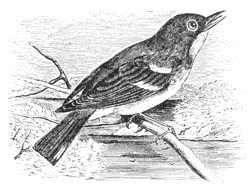
Parula americana.
In very brightly colored spring males, there is frequently (as in 58,335, Philadelphia) a well-defined, broad blackish band across the jugulum, anterior to an equally distinct and rather broader one across the breast, of a brown tint, spotted with black, while the sides are much spotted with chestnut-brown; the blue above is very pure, and the green patch on the back very sharply defined.
Habits. The Blue Yellow-Back is one of our most interesting and attractive Warblers. Nowhere very abundant, it has a well-marked and restricted area within which it is sparingly distributed. It is found from the Mississippi Valley to the Atlantic, and from Canada southward. In its winter migrations it visits the West Indies, the Bahamas, and Central and South America. Halifax on the east, and Platte River on the west, appear to be the northern limit of its distribution. Dr. Woodhouse met with it in the Indian Territory during the breeding-season. Mr. Alfred Newton found this species, apparently only a winter visitant, in the island of St. Croix. Most of the birds left about the middle of March, though a few remained until early in May.
A single specimen of this species was taken at South Greenland in 1857.
This Warbler has been found breeding as far to the south as Tuckertown, N. J., by Mr. W. S. Wood; and at Cape May, in the same State, by Mr. John Krider. At Washington, Dr. Coues found it only a spring and autumn visitant, exceedingly abundant from April 25 to May 15. Possibly a few remained to breed, as he met with them in the first week of August. In the fall they were again abundant from August 25 to the second week in October. He found them inhabiting exclusively high open woods, and usually seen in the tops of the trees, or at the extremities of the branches, in the tufts of leaves and blossoms.
Even where most common it is not an abundant species, and is to be found only in certain localities, somewhat open and swampy thickets, usually not of great extent, and prefers those well covered with the long gray lichens known as Spanish moss. In such localities only, so far as I know, do they breed.
This Warbler has also been ascertained to breed in Southern Illinois, where Mr. Ridgway found it in July, engaged in feeding fully fledged young birds. It is there most common in spring and fall.
A true Warbler in most of its attributes, this bird has many of the habits of Titmice. Like these it frequents the tops of the taller trees, feeding on the small winged insects and caterpillars that abound among the young leaves and blossoms. It has no song, properly so called, its notes are feeble and few, and can be heard only a short distance.
The song of this species is said by Mr. Trippe, of Orange, N. Y., to be a somewhat sharp and lisping, yet quite varied and pleasing, series of notes.
Mr. Audubon speaks of this species as breeding in Louisiana, but his description of the nest differs so entirely from such as are met with in Massachusetts as to suggest doubts as to the correctness of the identification. He describes them as flitting over damp places, the edges of ponds and streams, and pursuing their prey with great activity. They resort to the woods as soon as the foliage appears on the forest trees, and glean among the leaves for the smaller winged insects.
The nests of this Warbler, so far as has fallen under my observation, have always been made of long gray lichens still attached to the trees on which they grow. With great skill do these tiny architects gather up, fasten together, and interweave, one with the other, the hanging ends and longer branches. By an elaborate intertwining of these long fibres they form the principal part, sometimes the whole, of their nests. These structures are at once simple, beautiful, ingenious, and skilfully wrought. When first made, they are somewhat rude and unfinished, but as their family are gathered, the eggs deposited, incubated, and hatched, a change has been going on. Little by little has the male bird busied himself, when not procuring food for his mate, in improving, strengthening, and enlarging the nest. These same acts of improvement upon the original nests are noticed with Humming-Birds, Vireos, and a few other birds.
The nests are sometimes constructed on the sides of trunks of trees, when covered with the long gray lichens, but are more frequently found hanging from branches usually not more than six or eight feet from the ground. Thus surrounded by long hanging mosses in clumps not distinguishable from the nests themselves, they would not be readily recognized were it not that those familiar with the habits of the bird may be readily guided to the spot by the artless movements of the unsuspecting parents.
These birds are confiding, easily approached, and rarely exhibit any signs of alarm. Even when their nest is disturbed they make but little complaint, and do not manifest any very great signs of emotion. When built against a trunk these nests consist only of an interweaving of the moss above and below a very small opening, within which a small cup-shaped flooring has been made of the same material, and usually cannot be removed without destroying all semblance of a nest. When pensile they are imperfectly circular in shape, with an entrance on one side, and rarely with any lining. Occasionally they are models of symmetry and beauty.
The eggs, four or five in number, have a clear white ground, and are sparingly spotted with markings of reddish-brown, slate, purple, and lilac. In some the first predominate, in other the last three shades are more abundant, and usually form a confluent ring around the larger end. They measure from .62 to .65 of an inch in length, and from .49 to .50 in breadth.
Section SYLVICOLEÆThis section has been already characterized as having a distinctly notched bill, well provided with bristles. Of the two genera one, Perissoglossa, has the bill slender, acute, something like Helminthophaga, and with the tongue lengthened and much lacerated at end; the other, Dendroica, with less acute bill and tongue shorter, merely notched at tip, and a little fringed only.
Genus PERISSOGLOSSA, BairdPerissoglossa, Baird, Rev. Am. Birds, 1864, 181. (Type, Motacilla tigrina, Gm.)

Perissoglossa tigrina, Baird.
962
Gen. Char. Form of Dendroica, but bill slender, acute, with very obsolete notch; the commissure gently arched or curved from the base; the gonys also straight, or even slightly concave. Tongue lengthened, narrow, deeply bifid (for one third), and deeply lacerated or fringed externally at the end; the edge along the median portion folded over on the upper surface, but not adherent.
The curvature of the bill in Perissoglossa tigrina is quite peculiar among the Sylvicolidæ with notched bills. Some Helminthophagas (without notch) approximate this character, though in none, excepting H. bachmani, is it in equal amount,—all the others having the gonys very slightly convex, instead of straight, or even slightly concave.
It is most probable that the Helinaia carbonata of Audubon belongs here, as it appears very closely allied to the type of this genus. The two species may be distinguished as follows:—
Common Characters. Male. Top of head black. Above olive, becoming yellowish on rump. Head, neck, and lower parts bright yellow, becoming whitish posteriorly. Dorsal feathers with black centres; breast and sides streaked with black. A black streak through the eye.
P. tigrina. Large white patches on inner webs of tail-feathers.
Sides of head and middle of throat tinged with chestnut. One large white patch on wing, covering both rows of coverts. Outer web of lateral tail-feather blackish.
P. carbonata. No white patches on tail-feathers.
No chestnut about head. Two bands on the wing, the anterior one white, the posterior yellow. Outer web of lateral tail-feather whitish.
Perissoglossa tigrina, BairdCAPE MAY WARBLERMotacilla tigrina, Gmelin, Syn. Nat. I, 1788, 985. Sylvia tig. Lath. Dendroica tig. Baird, Birds N. Am. 1858, 286.—Sclater, Catal. 1861, 33, No. 198. P. Z. S. 1861, 71 (Jamaica, April).—March, Pr. An. Sc. 1863, 293 (Jamaica; breeds).—A. & E. Newton, Ibis, 1859, 144 (St. Croix. Notes on anatomy of tongue).—Gundlach, Cab. Jour. 1861, 326 (Cuba; not rare).—Samuels, 240. Perissoglossa tigrina, Baird, Rev. Am. Birds, 1864, 181. Sylvia maritima, Wilson, Am. Orn. VI, 1812, 99, pl. liv, fig. 3.—Bon.; Nutt.; Aud. Orn. Biog. V, pl. ccccxiv.—D’Orb. La Sagra’s Cub. 1840, 70, pl. x. Sylvicola mar. Jard., Bon., Aud. Birds Am. II, pl. lxxxv. Certhiola mar. Gosse, Birds Jam. 1847, 81.—Ib. Illust. Rhimamphus mar. Cab. Jour. III, 1855, 474 (Cuba.)
Sp. Char. Bill very acute, conical, and decidedly curved. Bill and feet black. Upper part of head dull black, some of the feathers faintly margined with light yellowish-brown. Collar scarcely meeting behind; rump and under parts generally rich yellow. Throat, forepart of breast, and sides, streaked with black. Abdomen and lower tail-coverts pale yellow, brighter about the vent. Ear-coverts light reddish-chestnut. Back part of a yellow line from nostrils over the eye of this same color; chin and throat tinged also with it. A black line from commissure through the eye, and running into the chestnut of the ear-coverts. Back, shoulder, edges of the wing and tail, yellowish-olive; the former spotted with dusky. One row of small coverts, and outer bases of the secondary coverts, form a large patch of white, tinged with pale yellow. Tertials rather broadly edged with brownish-white. Quills and tail dark brown, the three outer feathers of the latter largely marked with white on the inner web; edge of the outer web of the outer feathers white, more perceptible towards the base. Length, 5.25; wing, 2.84; tail, 2.15.
Female. Above olivaceous-ash, most yellowish on rump; no black nor chestnut on head. Wing-coverts inconspicuously edged with whitish. Tail-spots very inconspicuous. Beneath dull white tinged with yellowish on the breast, and streaked as in the male, but with dusky grayish instead of black.
Hab. Eastern Province of United States, north to Lake Winnipeg and Moose Factory; all the West Indies to St. Croix. Breeds in Jamaica. Not recorded from Mexico or Central America.
The chestnut about the head in adult males varies in amount with the individual; sometimes (as in 20,633, May, Moose Factory, Hudson’s Bay Territory) there is an oblong spot of chestnut in the middle of the crown, but generally this is absent. Very frequently the chestnut tinges the throat. All variations in these respects appear, however, to be individual, and not dependent at all on locality. West Indian specimens appear to be absolutely identical with those from North America.
Autumnal specimens are browner, the chestnut markings much obscured.
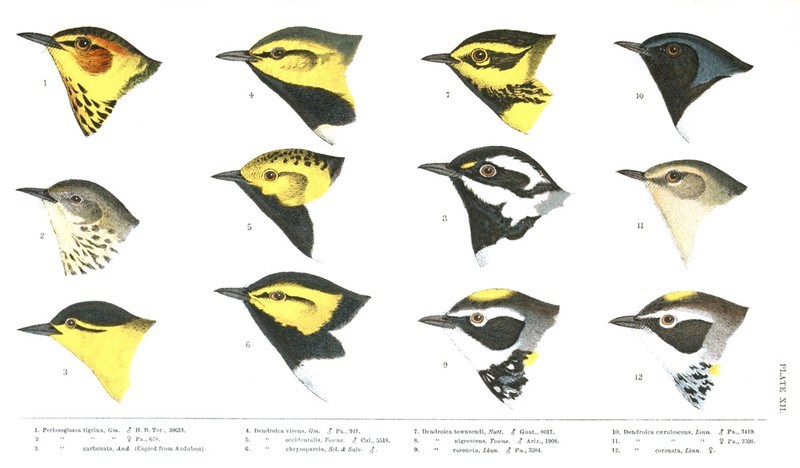
PLATE XII.
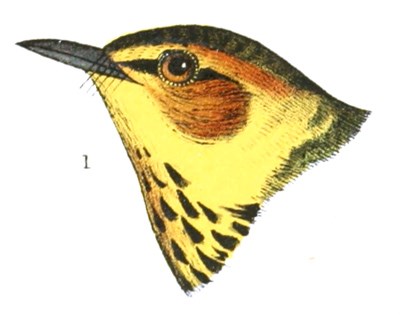
1. Perissoglossa tigrina, Gm. ♂ H. B. Ter., 20633.
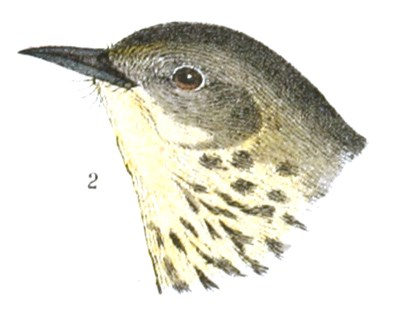
2. Perissoglossa tigrina, Gm. ♀ Pa., 678.
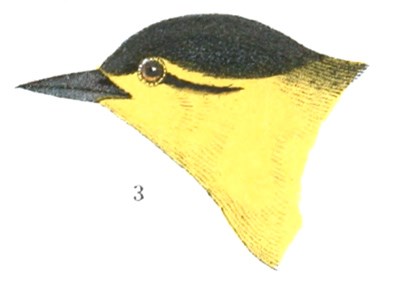
3. Perissoglossa carbonata, Aud. (Copied from Audubon).
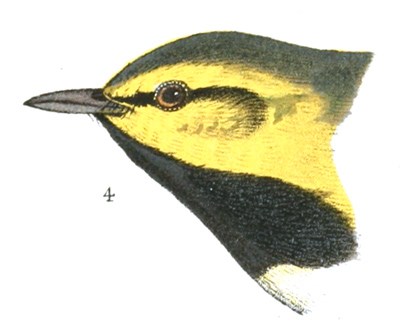
4. Dendroica virens, Gm. ♂ Pa., 941.

5. Dendroica occidentalis, Towns. ♂ Cal., 5518.
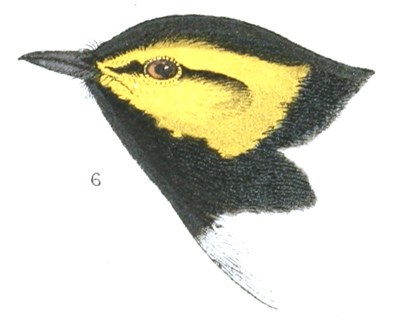
6. Dendroica chrysopareia, Scl. & Salv. ♂ .
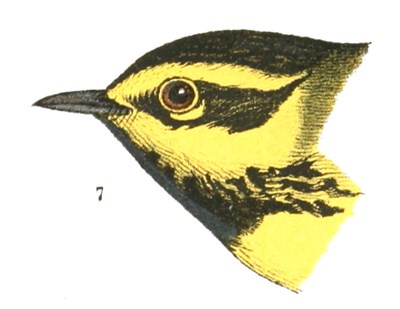
7. Dendroica townsendi, Nutt. ♂ Guat., 8017.
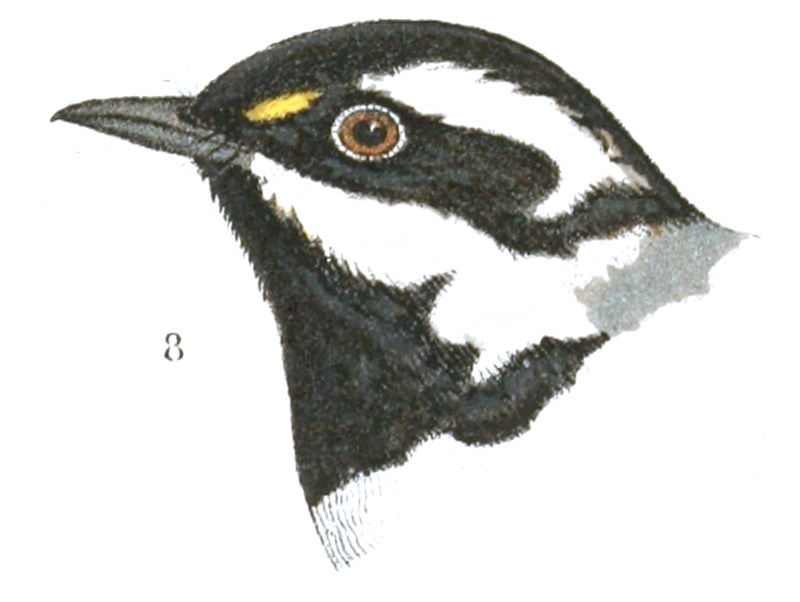
8. Dendroica nigrescens, Towns. ♂ Ariz., 1908.
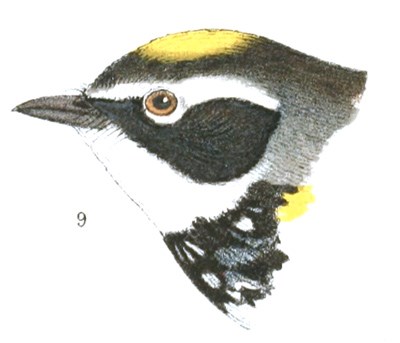
9. Dendroica coronata, Linn. ♂ Pa., 8384.
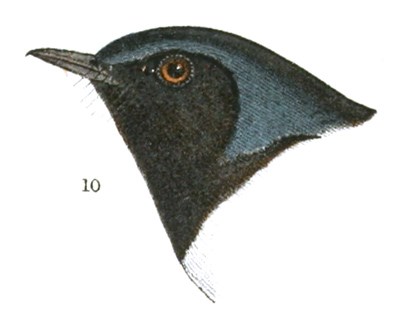
10. Dendroica cærulescens, Linn. ♂ Pa., 3419.

11. Dendroica cærulescens, Linn. ♀ Pa., 2308.
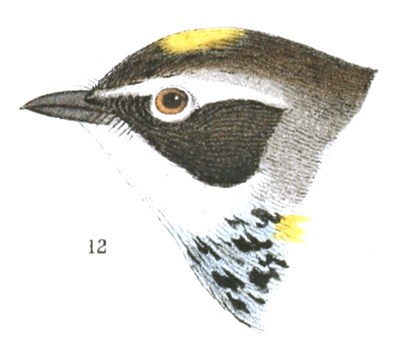
12. Dendroica coronata, Linn. ♀.
Habits. This somewhat rare species, so far as its history and distribution are known with certainty, is migratory in the principal portions of the United States, in the spring and fall passing to the north of the 42d parallel to breed. The first specimen was obtained near the extreme southern point of New Jersey by George Ord, in 1811, and described and figured by Wilson. From this accidental circumstance it derives its inappropriate name of Cape May Warbler. Wilson never met with a second specimen, and Mr. Nuttall was wholly unacquainted with it. Mr. Audubon also never met with a specimen in all his wanderings, and was able to add nothing to its history. Those figured by him were procured by Mr. Edward Harris, near Philadelphia, through which region these birds appear to pass rapidly in their northern migrations.
Mr. J. A. Allen obtained a specimen near Springfield, Mass., May 15, 1863, and specimens have also been procured at East Windsor Hill, Conn., by Dr. Wood. It was not met with in Western Maine by Mr. Verrill, but in Eastern Maine and in New Brunswick Mr. Boardman has found it a not uncommon summer visitant, though of irregular frequency. He has no doubt that they remain there to breed. They reach Calais as early as the second week in May, or as early as their appearance usually in the neighborhood of Philadelphia has been noticed. Mr. Kumlien has also obtained specimens from year to year, about the middle of May, in Southern Wisconsin, where they do not remain to breed, and Mr. Ridgway has taken them in the beginning of May in Southern Illinois.
It is also by no means uncommon in Cuba; was met by the Newtons as a migrant in St. Croix, and is not only one of the birds of Jamaica, but is resident and breeds in the highlands of that island. It is not known to occur in Central America, Mexico, or west of the Mississippi River. Specimens were procured at Moose Factory about May 28.
Its nests and eggs have not been, with certainty, obtained in the United States, though an egg obtained in Coventry, Vt., in 1836, and attributed at the time to this bird, closely resembles its identified eggs from Jamaica. Specimens of the bird, as well as its nests and eggs, have also been received from St. Domingo by Mr. Turnbull of Philadelphia. In the summer of 1871 a nest of this species was found by Mr. H. B. Bailey on the Richardson Lakes, in the extreme northwestern part of Maine. The nest was in a low spruce-tree, less than five feet from the ground, and when found contained only a single egg. Unfortunately it was left until more eggs were deposited, and in the mean while the tree was cut, and the nest and eggs were destroyed.
Mr. W. T. March of Jamaica, in his notes on the birds of that island, states that this species may always be found, in its various changes of plumage, about the mangrove swamps and river-banks. During the summer months it was common about Healthshire and Great Salt Pond, and at other times very generally distributed over the island. He also met with several specimens of its nests and eggs, but their position was not stated. The nests had apparently been taken from a bush or tree, were three and one fourth inches in diameter by two and one half in height, with cavities unusually large and deep for the size of the nests. They were wrought almost entirely of long strips of thin flexible bark, strongly and firmly interwoven. The outer portions consisted of coarser and longer strips, the inner being much finer and more delicate. With the outer portions were also interwoven bits of mosses, lichens, and the outer bark of deciduous trees. The entire fabric was a remarkable one.




